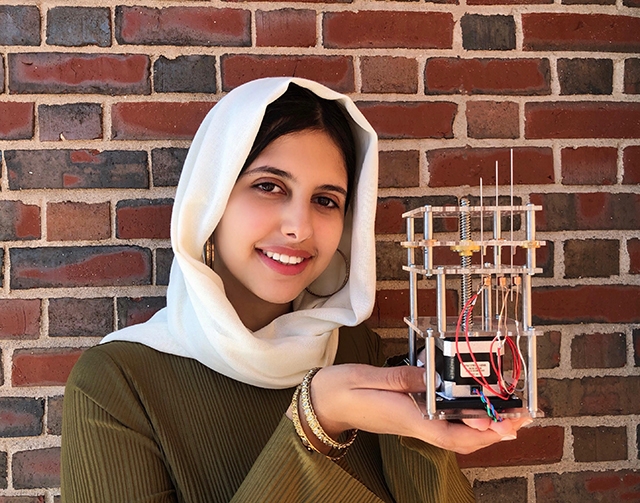Engineering Design Projects (ES 100), the capstone course at the Harvard John A. Paulson School of Engineering and Applied Sciences, challenges seniors to engineer a creative solution to a real-world problem.
3D Tactile Pin Matrix for Autonomously Reconstructing Environments in Realtime
Marwah Aman (Marwah Sabrah), S.B. ’21, mechanical engineering
Current accessibility tools for people with visual impairment are limited and cost tens of thousands of dollars; research shows that these devices don’t provide users with the information needed to build a spatial cognitive map of their surroundings. In particular, no portable practical technology yet exists to dynamically generate physical 3D models of a user’s surroundings for tactile information.
In her project, Aman pioneered a novel tactile pin matrix (TPM) device that autonomously reconstructs a physical 3D model of the user’s surroundings in near real-time. As objects such as cars or people pass by, the device translates that environment into a physical 3D model through the dynamic pins and the user is able to instantly perceive that motion by touching the pins for tactile feedback. The 3D object silhouettes generated by this device give the user information on distance, shape, size, and motion, allowing them to build a spatial cognitive map to reduce anxiety in unfamiliar spaces, improve obstacle avoidance and navigation, and minimize the need to request a guide.
The biggest challenge of a project like this is the independent precise actuation of hundreds of densely packed 1 millimeter thick pins, while keeping the device portable and low energy, Aman said. Her design optimizes magnetism and electropermanent magnets to be able to generate any 3D model using 200 pins in less than 250 milliseconds, with 0.5 millimeter precision. The device remains portable at 10x10x14 centimeters and 0.8 kilograms for a 200-pin model.
"Pursuing my project in a virtual environment has been an incredible opportunity to practice resilience and ingenuity in addressing complex problems when physical tools and lab access are restricted. For every typical manufacturing process, I had to figure out how to replicate that same quality of engineering design using only tools I had at home," she said. "I learned to conduct large scale analysis and to interface mechanical, electrical, and computer science principles. With the positive feedback I’ve received from dozens of engineers, this device will become my second patent and I’m looking forward to bringing it to market."
Press Contact
Adam Zewe | 617-496-5878 | azewe@seas.harvard.edu
